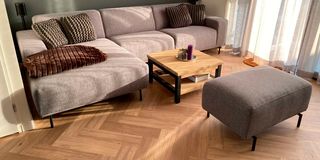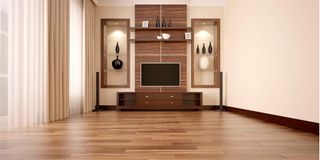Premium
Shopping for a floor? consider the following elements

Over the past decade, demands for efficiency, affordability and sustainability in the real estate industry have driven rapid innovation, with manufacturers leveraging on new technologies to enhance the marketability of construction materials.
Of all the building materials, flooring components have perhaps seen the most improvements. Being the only area that is commonly connected to all furniture and interiors, floors are a very important part of the interior.
As a result, manufacturers have invested in developing products that combine key considerations such as eye appeal, affordability and environmental sustainability. While eco-friendly flooring is by no means a newcomer in the flooring industry, new technology has made it possible to offer extensive eco-friendly options to fit more spaces, commercial and residential, more than ever before.
Hybrid Floor
A good example is the rigid or hybrid floor, which combines the benefits of laminate and vinyl flooring. This type of floor is made up of multiple layers of materials combined together to create a highly resilient base that can withstand daily use.
The material has a very high impact resistance that enables it to handle a lot of weight without leaving scratch marks. The top layer has a woody grain look which gives the floor its aesthetic appeal. It is also stain-resistant, therefore suitable for spaces with lots of traffic.
Meanwhile, the second layer is the waterproofing layer, which also helps the flooring withstand extreme temperature changes, while the bottom section offers comfort and soundproofing. Because of its qualities, this type of floor has become very popular over the past couple of years, and is now widely used in residential and commercial spaces.
“Eye appeal is one of the most prominent aspects of hybrid flooring. People want wood floors but do not have the time or money to maintain them. Hybrid boards combine the look of old-style wood with the durability of innovative technology,” comments Brian Sigei, a flooring expert.
Due to its vinyl element, hybrid flooring is 100 percent waterproof, all you need is to use the correct construction adhesive, with this in mind, hybrid flooring can be installed in every part of your home, including the kitchen, laundry room, and even the bathroom.
“It is designed with a wet-resistant coating in the middle of the board, then a top layer is added that prevents moisture from entering the layers. This gives the floor two layers of protection, making it safe to use in wet rooms,” adds Sigei.
This type of floor is also suitable for hot areas. This is because the boards expand and contract very little, even with underfloor heating or changing temperatures. As a result, your flooring will not rise, fracture, or buckle as the temperature changes.
Hardwood Floor
Another flooring material widely preferred for its aesthetic appeal is hardwood. It is mostly used in residential spaces, but has now also become popular in commercial buildings. Retail spaces looking to add a more rustic feel to the area, for instance, can use wood flooring to effortlessly bring the outdoors in.
Some of the common hardwood materials are bamboo and cork. Though it is a bit pricy, hardwood is more sustainable, as it is bio-based and renewable. Bamboo in particular grows very quickly, making it more sustainable in the long-run. With proper care and refinishing, a hardwood floor can be durable and long-lasting, however, should you want to install a floor in places where moisture levels are high, such as a basement, it is more advisable to go for alternatives such as engineered wood, which is more resistant.
“With proper care and maintenance, you won’t have to replace or repair your hardwood floor for a long time. It is, however, important to learn the proper ways to clean this kind of floor to maintain their luxurious appearance,” notes Sigei.
Finished hardwood is also easy to clean. You can easily sweep or vacuum the floor to get rid of dust, although using a soft brush is recommended to avoid scratching the surface.
Mopping with a cleanser or a damp mop will gently remove any existing stains. To restore the original sheen of the finish, hardwood floors can be polished using a soft cloth and a simple homemade solution.
Wooden planks are also easy to lay down and remove in case you need to replace them or relocate them. With the proper tools, they can also be trimmed on-site to rectify any inaccuracies with regard to measurements and height. Hiring a professional to lay down the planks is advisable to avoid making mistakes that could cost you more money in repair and re-installation.

Hardwood flooring material does, however, also come with its fair share of disadvantages. For instance, hardwood material is easily prone to termite damage. Termite damage can be devastating. That means that if you opt for wooden flooring, you would have to inspect your floor every few months to ensure that it has not fallen prey to termites.
Hardwood is also prone to water damage. Spilling of fluids, cleaning with lots of water, and moisture will generally expand the wood, and after some time, this will require expensive repair work. Constant inspection is therefore important because it will enable you make timely repairs, which will also be inexpensive.
Another concern with hardwood flooring is that while new, it won’t make any noise, but over time, the wear and tear arising from the weight of foot traffic will make it squeaky and creaky. Hardwood floor surfaces are also easily scratched by pets or heavy movements such as dragging of furniture.
Then again, the scratches on hardwood are very noticeable, which, in turn, makes the flooring look aged before its time. Wooden floors also tend to look dull over time and therefore require polishing every now and then to maintain their sheen. This leaves you with high maintenance costs over time.
“Modern homes generally have sealed and finished hardwood flooring. These serve as protective layers that keep away moisture while adding a polished look to the wood. Unfortunately, they are prone to wear and tear, which means you must have the floor re-sealed or polished every time there is damage. If left unmaintained, you run the risk of exposing the wood to moisture, dirt, mold and termites,” adds Sigei.
Even though wooden floors help to save on a lot of maintenance costs in the long-term, the initial investment for the homeowner is generally high as they are expensive.
The cost of materials can average between Sh300 and Sh700 per square foot. Hardwood installation costs are also high, averaging between Sh600 and Sh1,200 per square foot.
Laminate Flooring
If you are on a tight budget, however, you could consider alternatives such as laminated flooring solutions, which are slightly cheaper than hardwood flooring even though they are just as aesthetically pleasing. Laminate flooring emulates the look of hardwood and is a great option for homeowners looking for a versatile and durable surface. Even the highest quality, best-looking laminate flooring options are relatively affordable, easy to clean and maintain and will last a long time.
Sigei observes that interior design is not only about the material used, but also about its harmony to the structural space available. Laminated flooring gives high value to your interiors by giving wooden properties to the floor, and by extension furniture, while retaining the modern trends to suit your interior needs. Not only are laminated eco-friendly and budget friendly, they are also easy to install using a tongue-and-groove locking technique that is not bonded to a subfloor with an adhesive.
Resilient floors
Perhaps one of the biggest breakthroughs in flooring, however, has been the development of resilient flooring materials using new technologies. While ceramic tiles can crack, solid hardwood flooring can swell when wet, and laminates can de-laminate, resilient floors, as the name suggests, is a category of flooring products that possess the physical strength and flexibility to stand up to nearly anything thrown at them, be it spillage, heavy objects or scratching.
“Resilient flooring has seen the fastest growth, more than any other flooring materials over the last couple of years. It’s competitively priced, visually authentic, mimicking hardwood, tile or stone, durable and versatile, moisture resistant and can be installed with or without adhesives,” says the expert.
Resilient floors come in a variety of categories. The most commonly found resilient flooring material currently is vinyl. Floor manufacturers have used vinyl to engineer various products which include Vinyl Composition Tile (VCT), Solid Vinyl Tile (SVT), and Luxury Vinyl Tile (LVT) or Planks (LVP). Of all vinyl products, the luxury vinyl tiles (LVT) or planks (LVP), are the most popular. They emulate ceramic tiles, and are more luxurious in appearance and colour than the other vinyl products.
In appearance, it is difficult to tell the difference between the LVT and more expensive flooring materials such as hardwood, stone or ceramic tile. You can also easily replace vinyl tiles or planks as needed, without having to replace the entire floor. These qualities make LVT the hottest hard surface flooring material on the market.
Meanwhile, vinyl composition tile (VCT) is most often used in commercial applications such as grocery stores, drug stores, and hardware stores due to its hard surface properties which make it ideal for use in high-activity areas - PVC-free vinyl flooring material has also emerged recently as a high-performance alternative to sheet vinyl and tile flooring products for use in commercial spaces. It is tough, enabling it to withstand the weight of heavy furnishings and avoid indentations. It also uses an applied adhesive which prevents damage from moisture or alkalinity.
When it comes to resilient flooring, vinyl sheets are a great choice. Not only are they durable, they now have more colour and design options for those looking for practical yet stylish commercial flooring
Other resilient flooring materials include linoleum, a natural product comprising linseed oil derived from flax plants, wood, limestone, cork, resins and other recycled products. Though not very common nowadays, this material is good for its durability, as it can easily withstand heavy traffic and scratches over time, without losing its colour.
Rubber is also used as a resilient flooring material. Once made of organic rubber from rubber trees, this category of flooring is now mainly produced from synthetic rubbers. For its durability, slip resistance, water resistance, softness and easy-to-clean features, rubber is ideal for hard-wearing commercial or residential environments such as restaurant kitchens and gyms, as well as basements.
Obviously, with flooring manufacturers committed to developing and producing environmentally responsible flooring materials, homeowners, whatever their budget, can easily get the floor that meets their needs.





